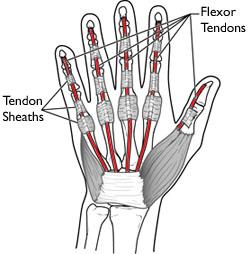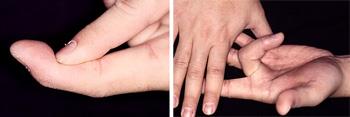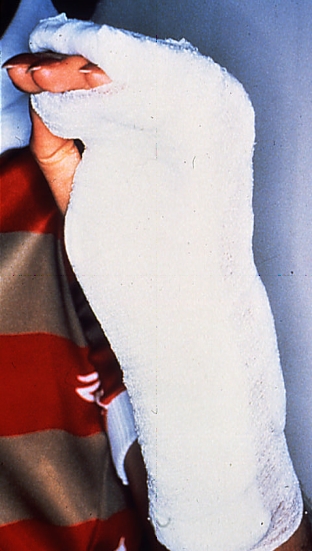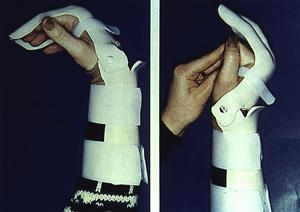Diseases & Conditions
Flexor Tendon Injuries
Flexor tendons are cord-like structures running from the forearm across the wrist and palm and into the fingers, allowing you to bend your fingers and thumb to grasp an object or make a fist. Injuries to the flexor tendons can cause you to lose the ability to bend one or more of the joints in your hand.
Flexor tendon injuries typically occur from a cut on the palm side of your fingers, hand, wrist, or forearm. Flexor tendons can also be injured when a finger or thumb is violently pulled away from you while you are attempting to grasp something, such as the jersey of an opposing player in sports. While an open cut may cause a tendon laceration, a sudden and forceful pull against the tendon may cause a tendon rupture.
Anatomy
Tendons are strong cords that connect muscles to bone. When muscles contract, their tendon(s) pull through the attachments to bone and cause a joint to move.
The muscles that move the fingers and thumb are located in the forearm and hand. Long tendons run from the end of the muscles through small tunnels in the wrist and hand to attach to the small bones (phalanges) of the fingers and thumb. These tunnels are called tendon sheaths. The tendon sheaths keep the tendons close to the bones and joints and also provide lubrication to the tendons to help them glide freely.
Description
A cut or ruptured tendon in the forearm, at the wrist, in the palm, or along the finger will make it difficult or maybe impossible to bend one or more joints in a finger.
Like a rubber band, the flexor tendons are under tension as they connect the muscle to the bone. If a tendon is torn or cut, the ends of the tendon likely will be pulled apart, making it impossible for the tendon to heal on its own because of the gap between the two ends.
It is not uncommon for other structures to be injured at the time of a cut flexor tendon. Because the nerves and blood vessels to the fingers are very close to the tendons, a cut may damage them, as well. This can cause numbness on one or both sides of the finger. If blood vessels are also cut, the finger may have no blood supply, which can cause loss of the finger. This requires immediate surgery.
Occasionally, flexor tendons may be partially cut or torn. With a partial tendon injury, it may still be possible to bend your finger. However, partial tendon injuries may result in incomplete bending of the finger, excessive pain, or even catching or locking of the finger during movement. Partial injuries to the tendons can be difficult to diagnose.
Causes
In addition to cuts on the arm, wrist, hand, or fingers, certain sports activities can cause flexor tendon injuries. These injuries often occur in football, wrestling, and rugby. Jersey finger is one of the most common of these sports injuries. It can happen when one player grabs another's jersey and a finger (usually the ring finger) gets caught and pulled with great force. This can cause the tendon to be pulled off the bone.
In activities that require a lot of hand strength (e.g., rock climbing), tendons and/or their sheaths can also be stretched or torn. The crimp-grip position of the fingers necessary for rock climbing places a great deal of strain on the pulleys of the tendon sheath and can cause a rupture of the sheath. When this occurs, it can limit how much the finger can bend or flex and can cause pain when moving the finger.
Certain health conditions (rheumatoid arthritis, for example) weaken the flexor tendons and make them more likely to tear or rupture. This can happen without warning or injury — a person may simply notice that their finger no longer bends but not recall how it happened.
Symptoms
The most common signs of a flexor tendon injury include:
- An open injury, such as a cut, on the palm side of your hand, wrist, or forearm
- An inability to bend one or more joints of your finger
- Pain when you attempt to bend your finger
- Tenderness along your finger on the palm side of your hand
- Numbness in your fingertip
Doctor Examination
It is important to see a doctor whenever the fingers are injured. This is especially true for an open injury or cut in the skin, and when you are concerned that you might have a tendon injury. Generally, it is recommended that flexor tendon injuries should be repaired within 7 to 10 days of the injury, although early evaluation is important.
First Aid
When you have a serious cut to your hand or fingers:
- Apply a compression wrap to your hand with a clean cloth or bandage to slow down the bleeding.
- Irrigate the wound with sterile saline to reduce the risk of infection.
- Apply ice or a cold pack to help reduce swelling after the injury.
- Elevate your hand by keeping it lifted above your heart.
- See a doctor as soon as possible. Depending on the severity of the injury, it might be appropriate to go to an urgent care center or emergency room to evaluate your hand for a tendon, nerve, blood vessel, or bone injury.
- You may need a tetanus shot or antibiotics to prevent infection.
Physical Examination
During the examination:
- Your doctor will ask you to bend and straighten your fingers.
- To test your finger strength, your doctor may have you try to bend your injured finger while they hold the other fingers down flat.
- To determine whether any nerves or blood vessels have been injured, your doctor may test your hand for sensation and blood flow to the fingers.
Additional Tests
Your doctor may also order an X-ray to see if there is any damage to the bones of the hand, wrist, or forearm.
Treatment
After examining your hand, your doctor may clean your open wound(s) and close the wound(s) to reduce the risk of infection. They may place your hand in a splint to protect the injured structures.
Tendons cannot heal unless the ends are touching. In most cases, a cut or torn tendon must be repaired by a surgeon.
Surgery is usually performed within 7 to 10 days after an injury. In general, the sooner surgery is performed, the better recovery will be.
If your injury is restricting blood flow to your hand or finger, your doctor will schedule an immediate surgery. If you are concerned that your finger may need immediate attention, do not eat or drink anything, as this may delay surgery. Go immediately to an emergency room.
Surgical Procedure
Because tendons tear in different ways — such as straight across, at an angle, or pulled right off of the bone — there are many different methods for your surgeon to repair them. Most, if not all of the methods for repair, however, involve special sutures, or stitches.
Your fingers and wrist may be placed in a bent position to keep tension off the repair.
Often, depending on your injury, your surgeon will refer you to a hand therapist for several days after your surgery to begin surgical exercises that protect the tendon repair but encourage the tendons to move or glide within the tendon sheath.
It is important that you follow the instructions of your surgeon and your therapist to avoid damaging the tendon repair. The outcome of the repair will depend greatly on your ability to follow the instructions of your surgeon and therapist.
Recovery from Surgery
A flexor tendon takes approximately 3 to 4 months to heal before your hand is strong enough to use without restrictions. Usually, you will be required to wear a protective splint for approximately 6 to 8 weeks after surgery, removing it only to do exercise prescribed by your doctor and therapist. The exercises will help you to gradually regain motion and function.
Stiffness after surgery is common, but it usually responds to therapy.
Sometimes after flexor tendon surgery, scar tissue may cause the tendon to stick to the tendon sheath. If this does not approve adequately with therapy, you may require an additional surgery called a tenolysis.
The tenolysis is performed after the tendon ends have healed well enough, at about 4 to 6 months from the repair. Tenolysis helps to free up the tendons so they can glide freely in the tendon sheath and improve the movement of your injured finger or thumb.
Splint wear and proper exercise, exactly as prescribed by your therapist, are as important to recovery as the surgery itself.
Treatment for Partial Tears
Recent evidence suggests that partially torn tendons may not require surgery for good results. The same splinting and exercise programs that are used for surgery patients can be very effective for patients with partial tears, but with no surgery necessary.
This nonsurgical treatment option is appropriate only after the doctor has explored the wound to accurately assess the extent of the injury.
Long-Term Outcomes
Over the last several decades, advanced research and experience in the treatment of flexor tendon injuries have resulted in improved patient outcomes.
Flexor tendon injuries, however, can be very challenging to treat. Even in the best of hands, some patients develop stiffness and poor function of a digit after flexor tendon injury and repair.
For this reason, it is very important to be seen promptly if you are concerned you may have a flexor tendon injury. It is also essential to work with therapy and follow all instructions after you undergo a flexor tendon repair to optimize your outcome.
Overall, despite its challenges, flexor tendon surgery results in good return of function and high patient satisfaction for many patients.
Contributed and/or Updated by
AAOS does not endorse any treatments, procedures, products, or physicians referenced herein. This information is provided as an educational service and is not intended to serve as medical advice. Anyone seeking specific orthopaedic advice or assistance should consult his or her orthopaedic surgeon, or locate one in your area through the AAOS Find an Orthopaedist program on this website.











